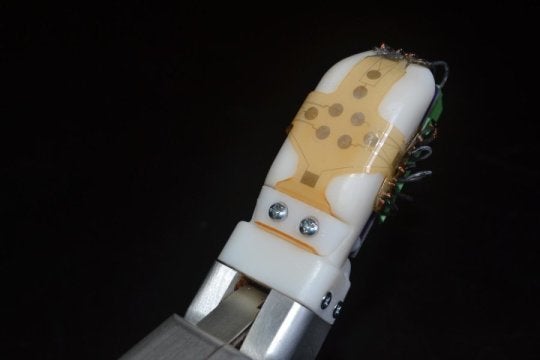In their quest to take over the world and replace human beings, robots were missing one always crucial element - the ability to perform tasks quite as effectively as people do.
But now all that has changed.
A team of robotics engineers in the USA have made an “important breakthrough” in developing a flexible skin that allows machines to feel what they are doing (and when it is going wrong) so they can rectify the situation.
It’s a feature that will make them better at everything from cooking an omelette to dismantling roadside bombs.

In order for robots to perform delicate tasks, such as cooking, housework, or surgery, they need to know whether a small or delicate object is slipping out of their grasp.
Jonathan Posner, a senior author on the study, said: “If a robot is going to dismantle an improvised explosive device, it needs to know whether it’s hand is sliding along a wire or pulling on it. Or to hold on to a medical instrument, it needs to know if the object is slipping.”
To date it has been impossible for robotic hands to accurately sense the vibrations and forces that occur, for example, when an object is starting to fall.
Some robots already use fully instrumented fingers but that sense of ‘touch’ is still limited to that appendage and such skins have not yet provided a full range of tactile information.
But the team from the University of Washington have now created a bio-inspired skin that can be stretched over any part of a robot, or prosthetic, to successfully grasp and manipulate objects in everyday tasks.
This is a giant step forward in the effective application real-world of robotics.
The skin, manufactured at the nanofabrication facility, is made from the same silicone rubber used in swimming goggles and embedded with tiny serpentine channels that are roughly half the width of a human hair.
These channels are filled with electronically conductive liquid metal, which won’t crack or fatigue as solid wires do.
And prototypes have shown they are able to measure tactile information with more precision and sensitivity than human skin.
This development is so important because it will allow robots in the future to open doors, interact with a phone, shake hands, pick up packages, and handle objects, among many other things.
Associate professor Veronica Santos, says: “The fact that our latest skin prototype incorporates all three modalities creates many new possibilities for machine learning-based approaches for advancing robot capabilities.”
Scarily human.
